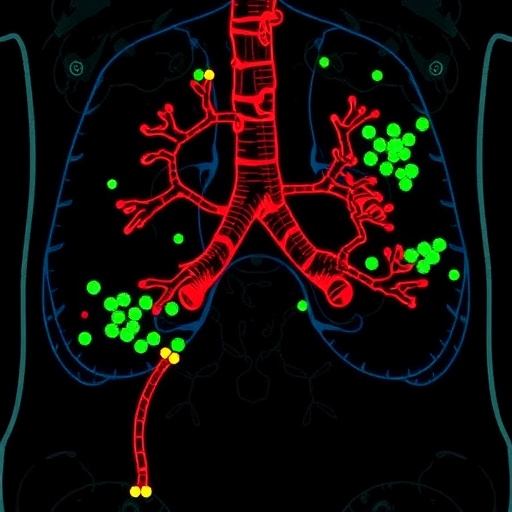
In a groundbreaking study that bridges molecular biology and clinical oncology, researchers have unveiled an innovative prognostic tool grounded in the complex landscape of liquid–liquid phase separation (LLPS) patterns to predict outcomes and therapeutic responses in pediatric acute myeloid leukemia (P-AML). This advancement holds promise for transforming how clinicians approach this formidable childhood malignancy by integrating sophisticated molecular signatures with immune landscape profiling and drug sensitivity predictions.
Pediatric acute myeloid leukemia remains a pressing clinical challenge despite the gradual improvements in survival rates achieved over the past decades. Although the five-year survival has edged upward, relapse rates stubbornly remain high, posing considerable barriers to effective long-term disease management. One major shortcoming in current clinical practice is the absence of reliable biomarkers that can accurately forecast prognosis or predict responses to emerging immunotherapies and targeted treatments.
The study, recently published in BMC Cancer, leverages the nascent but rapidly expanding field of liquid–liquid phase separation — a cellular biophysical phenomenon underpinning the formation of membraneless organelles and spatial organization of biochemical reactions. LLPS influences the assembly and dynamics of biomolecular condensates, tightly regulating gene expression, signal transduction, and other critical cellular functions. Emerging evidence has implicated aberrant LLPS in cancer development and progression, yet its specific role in pediatric forms of acute myeloid leukemia had remained elusive until now.
.adsslot_HTDCgcu5Nn{width:728px !important;height:90px !important;}
@media(max-width:1199px){ .adsslot_HTDCgcu5Nn{width:468px !important;height:60px !important;}
}
@media(max-width:767px){ .adsslot_HTDCgcu5Nn{width:320px !important;height:50px !important;}
}
ADVERTISEMENT
Employing a comprehensive multi-omics approach, the researchers mined both bulk and single-cell RNA sequencing datasets from a well-characterized cohort of P-AML patients. Their meticulous analyses focused on the expression profiles of genes associated with LLPS, seeking to decipher distinct molecular patterns that correspond to clinical outcomes. By integrating multiple advanced statistical models—including Kaplan–Meier survival analysis, LASSO regression, stepwise Akaike information criterion (stepAIC), and Cox proportional hazards models—they distilled a robust prognostic signature rooted in LLPS biology.
This LLPS-based risk model demonstrated remarkable power in stratifying pediatric AML patients into high- and low-risk categories, with clear differences in overall survival outcomes. Validated across independent external cohorts, the model underscores the reproducibility and clinical potential of LLPS gene expression as a prognostic biomarker. It marks a significant departure from traditional risk stratification methods that rely primarily on cytogenetics or broad molecular markers, offering a more nuanced understanding tethered to fundamental biophysical cellular processes.
To further bridge this prognostic model to clinical decision-making, the team constructed a nomogram that integrates the LLPS risk scores with conventional clinical parameters, enhancing its practical usability in real-world settings. This integrative tool aims not only to predict patient prognosis but also to inform personalized treatment strategies by identifying those who may derive benefit from specific immunotherapies and targeted agents.
Diving deeper into the tumor microenvironment, the researchers leveraged single-cell transcriptomic data to examine immune cell infiltration and checkpoint molecule expression patterns within P-AML samples. These analyses revealed that the LLPS signature is intimately linked with hallmark pathways of cancer, immune evasion, and microenvironmental remodeling. Particularly notable was the association between LLPS patterns and the expression of immune checkpoint genes, which are pivotal determinants of response to immune checkpoint blockade therapies.
The study’s exploration into drug sensitivities unveiled compelling distinctions between patients in different LLPS-defined risk groups. High- and low-risk P-AML patients exhibited varying susceptibilities to commonly used chemotherapeutics and targeted agents such as Docetaxel, Paclitaxel, and Sunitinib. This finding suggests that the LLPS-based model could serve as a valuable predictive platform not only for survival but also for tailoring drug regimens that maximize efficacy while minimizing unnecessary toxicity.
Importantly, by integrating multi-omic layers—ranging from bulk RNA sequencing to single-cell resolution data—the work exemplifies the power of systems biology approaches in unraveling the complex interplay between cancer cells and their immune milieu. Such integrative analyses are key to developing precision medicine strategies capable of adapting to the heterogeneous nature of P-AML and its diverse clinical trajectories.
This research also underscores the transformative role of LLPS in oncogenesis beyond mere gene mutations or chromosomal abnormalities. By highlighting how the spatial and temporal organization of biomolecular condensates can influence tumor behavior and therapy response, the study opens new avenues for therapeutic intervention targeting LLPS dynamics and their molecular regulators.
From a translational perspective, implementing this LLPS-derived risk model in clinical workflows could revolutionize pediatric AML management. It promises not only improved risk assessment but also a roadmap for optimizing immunotherapeutic strategies, potentially overcoming resistance mechanisms that have hampered treatment success to date.
Moreover, the identification of LLPS patterns as biomarkers suggests compelling possibilities for future drug discovery. Molecules that modulate phase separation processes or reprogram aberrant condensates may emerge as novel therapeutic agents, adding a fresh dimension to the armamentarium against pediatric leukemias.
Beyond its immediate clinical implications, this study exemplifies an emerging paradigm where physical principles of cell organization intersect with molecular oncology to inform patient care. Understanding LLPS dynamics offers a window into cancer’s vulnerabilities that might otherwise remain concealed within traditional genetic and epigenetic frameworks.
The robustness and broad validation of the model across independent datasets lend credibility to its findings and pave the way for prospective clinical trials. Such trials will be critical to ascertain the true utility of LLPS-based prognostication and its ability to guide treatment in pediatric AML.
This work also highlights the indispensable role of single-cell sequencing technologies in capturing tumor heterogeneity and microenvironmental complexity. By dissecting cellular subpopulations and their unique LLPS-related gene expression profiles, researchers gain unparalleled insights that can drive more tailored and effective interventions.
In conclusion, the study represents a major leap forward in understanding and harnessing LLPS biology for the benefit of children afflicted by acute myeloid leukemia. It lays a strong foundation for next-generation predictive models that integrate biophysical, molecular, and immunological data to confront one of pediatric oncology’s most resilient adversaries.
As the oncology community continues to seek breakthroughs in personalized medicine, the integration of LLPS signatures into clinical paradigms may well become a cornerstone of future therapeutic innovation, offering hope for improved survival and quality of life among young patients.
Subject of Research: Investigation of liquid–liquid phase separation (LLPS) patterns in pediatric acute myeloid leukemia (P-AML) to develop a prognostic risk model and predict immunotherapy and targeted therapy responses.
Article Title: Leveraging diverse liquid–liquid phase separation patterns to predict the prognosis and immunotherapy of pediatric acute myeloid leukemia
Article References:
Kong, M., Yang, Y., Wu, Z. et al. Leveraging diverse liquid–liquid phase separation patterns to predict the prognosis and immunotherapy of pediatric acute myeloid leukemia.
BMC Cancer 25, 1326 (2025). https://doi.org/10.1186/s12885-025-14718-4
Image Credits: Scienmag.com
DOI: https://doi.org/10.1186/s12885-025-14718-4
Tags: biomarkers for pediatric AMLclinical challenges in pediatric AMLdrug sensitivity predictions in leukemiaimmune landscape profiling in oncologyliquid-liquid phase separation in cancermolecular biology in cancer treatmentpediatric acute myeloid leukemia prognosispediatric cancer research advancementsphase separation patterns and disease outcomesrelapse rates in childhood leukemiatargeted treatments for pediatric cancerstherapeutic responses in childhood leukemia





